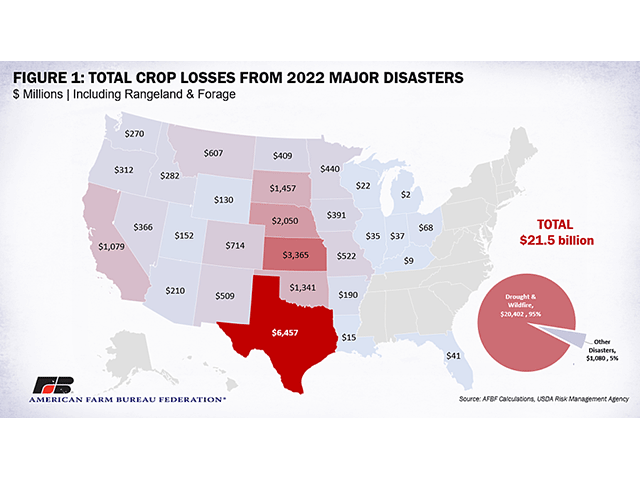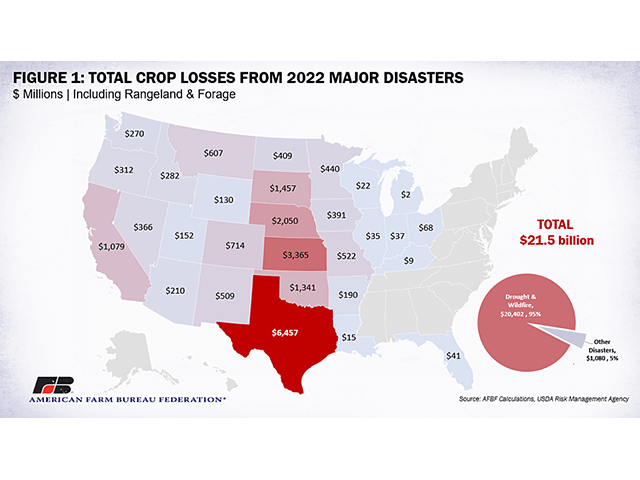Ag Policy Blog
USDA Pushes Back on Congressional Criticism of ERP Payment Math
OMAHA (DTN) -- USDA is pushing back on questions from Congress about how the department came up with its payment factor for the 2022 Emergency Relief Program (ERP).
Members of Congress from both parties sent letters to USDA this week questioning the methodology for issuing payments under the Emergency Relief Program (ERP), which skews payments to provide a higher percentage of aid for smaller losses. A dozen Republican senators wrote the Government Accountability Office asking for an examination into USDA's "progressive payment factor" that they see as disadvantaging larger farmers who had the biggest disaster losses.
The GOP blog cited that farmers with losses under $30,000 receive higher ERP payments under USDA's progressive factor. Farmers with larger losses than $30,000 see their payments go down compared to having a flat factor for payments.
In a response to DTN, USDA broke down the total number of producers in which the payment received under Track 1 of ERP was greater than or equal to 27%, which was a "flat factor" and which producers received less than the 27% factor.
USDA issued a total of 344,773 payments, but that involved 210,500 farmers because some producers received payments for multiple crops. Out of those 344,773 payments, 278,834 of payments, or 81%, were equal or greater than what they would have been under the 27% payment factor. Another 19% of payments, or 65,939, were less than the 27% factor.
With more than 80% of all payments coming in at $30,000 or less, nearly 170,000 farmers received higher payments than they otherwise would have collected. About 40,500 farmers -- likely with higher losses -- are receiving lower payments than expected.
SOME STATE COMPARISONS
In Illinois, for instance, 95% of farmers, or 6,557 producers who qualified, will receive greater or equal payments than they would have received under a flat 27% payment factor.
Among states with higher numbers of disaster-aid recipients, California was one where just 59% of farmers are receiving equal or higher payments, 6,538 of them. Another 41%, or 4,487 farmers are receiving lower payments.
Nebraska is the state with the highest number of farmers receiving lower payments at 8,945 farmers, which makes up 23% of the farmers eligible for ERP payments in that state. Another 30,711 farmers, or 77%, in Nebraska are receiving equal or higher payments.
USDA: LOSSES HIGHER THAN FUNDS AVAILABLE
A USDA spokesperson stated to DTN that it would have been "unavoidable" that all farmers would receive less assistance compared to prior years under ERP because Congress provided $3.2 billion in assistance to cover nearly $12 billion in uncovered crop losses.
P[L1] D[0x0] M[300x250] OOP[F] ADUNIT[] T[]
The American Farm Bureau Federation last spring projected the uncovered losses around $10.5 billion.
The USDA spokesperson stated, "This unfortunate circumstance required USDA to make decisions and develop a formula that would ensure farmers whose operations were most at risk because of unpreventable losses were the ones who received the smallest reductions on their payments. That means, for example, that the smallest operations that are least able to withstand a financial blow were prioritized as part of our goal, through this and other programs, to keep farmers on their land."
The USDA spokesperson added that a system that provides more disaster assistance to larger farmers actually "picks winners and losers" rather than tilting payments more towards smaller farmers.
"We hope that Congress will take note of this situation as they make funding decisions going forward, and that they consider how designing programs that best help the largest farms is in fact the real system that picks winners and losers while tying USDA's hands."
USDA officials also noted more than $19 billion in crop insurance indemnities were also paid out to producers as well through crop insurance or USDA risk-management programs.
USDA also had paused ERP payments while the Farm Service Agency (FSA) finalized some verification processes to prevent improper payments, the spokesperson stated. FSA started sending ERP payments back out again on Dec. 5.
PAYMENTS TO LARGER STATES
Among states with at least 10,000 ERP payments received, the number of producers receiving equal or higher payments broke down as such:
-- Kansas: 45,132 farmers, 82% are receiving equal or larger payments than they otherwise would have received. On the negative side, 10,217 farmers, 18%, are receiving lower payments.
-- Texas: 46,242 farmers, 85%, are receiving equal or greater payments; 7,967 farmers, 15%, received lower payments.
-- Nebraska: 30,711 farmers, 77%, are receiving equal or larger payments; 8,945 farmers, 23%, are receiving lower payments.
-- South Dakota: 15,260 farmers, 71%, are receiving equal or larger payments; 6,176 farmers are receiving lower payments.
-- North Dakota: 14,404, 78%, are receiving equal or larger payments; 4,145 farmers, 22%, are receiving smaller payments.
-- Iowa: 13,510 farmers, or 85%, are receiving equal or larger payments; 2,451 farmers, or 15%, are receiving smaller payments.
-- Minnesota: 12,824 farmers, 86%, will receive equal or larger payments; 2,158 farmers, 14%, are receiving smaller payments.
-- Oklahoma: 10,881 farmers, 81%, will receive equal or larger payments; 2,584 farmers, 19%, are receiving smaller payments.
-- Missouri: 9,777 farmers, 86%, will receive equal or larger payments; 1,612 farmers, 14%, are receiving lower payments.
-- Colorado: 8,233 farmers, 80%, will receive equal or larger payments; 2,070 farmers, 80%, are receiving lower payments.
-- California: 6,538, 59% will receive equal or larger payments; 4,487 farmers, 41%, are receiving lower payments.
USDA ERP portal: https://www.fsa.usda.gov/…
See, "Disputes About Payment Factors for ERP Disaster Aid and Funding Shortage for PARP," https://www.dtnpf.com/…
Also see, "Democrats Join Republican Criticism of USDA's Emergency Relief Program Payment Formula,"
Chris Clayton can be reached at Chris.Clayton@dtn.com
Follow him on X, formerly known as Twitter, @ChrisClaytonDTN
(c) Copyright 2023 DTN, LLC. All rights reserved.






Comments
To comment, please Log In or Join our Community .